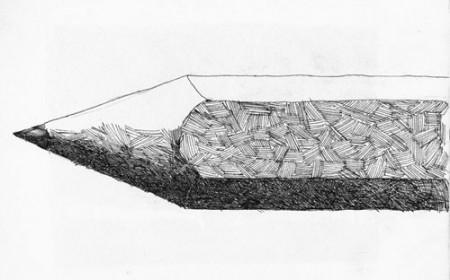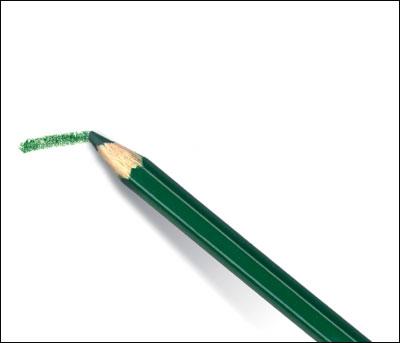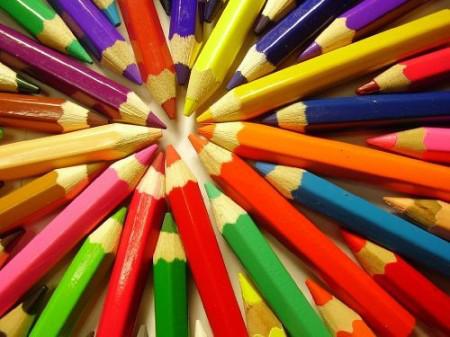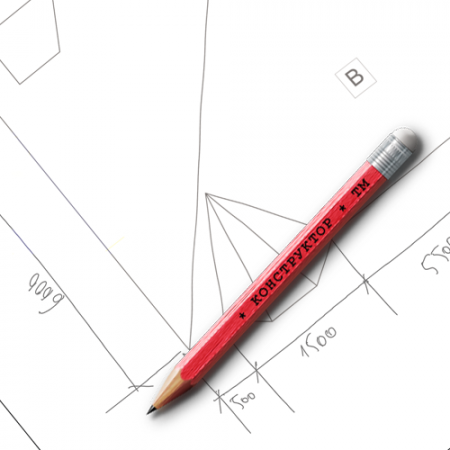3693
Complex history of a pencil

It is possible that soon humanity unlearn to write what is called - by hand, lose centuries of skill to drive a pen on paper, in fact much more convenient and faster squeal text on a computer keyboard. The rapid development of communication technology to confirm this, somewhere sad thought. Calligraphy lessons sink into oblivion as Latin, weaving bast and rustic spindle. What can you do? Life goes on.
But it is impossible to imagine that humanity has ceased to draw. Write - is to communicate with others, to draw - it's only with yourself. The child begins to draw much earlier than writing. "Kal-Malle" on paper wallpaper father's house - the first sweet creativity, has the same root with the cave paintings of prehistoric man. As always drawing, so it turns out, eternal drawing tool.
History of the pencil begins with the XIV century. Artists painted then mostly sticks made from a mixture of lead and zinc, sometimes called "silver pencil." These tools used by such masters graphics as Dürer, Van Eyck and Botticelli.
Charcoal is still used, as in ancient times, but not in the form of a campfire embers, and, for example, specifically in treating furnace willow sticks in a pot sealed with clay.
Prototypes modern graphite pencil appeared in the XVI century. English shepherds from the Cumberland area opened in the dark mass of the earth, which was used to mark sheep. Initially, because of the color, similar to the color of lead, the deposit taken for deposits of this mineral used for casting bullets. But by defining new material unsuitable for this purpose, began to make out of it at the end of a thin, pointed sticks and used them to paint. They were soft, and get your hands dirty for drawing, but not for writing. In the XVII century graphite commonly sold on the streets. Buyers, mostly artists, these graphite rods clamped between pieces of wood or branches, wraps them in paper or fasten with string.
From prototypes most likely related to the appearance of the word "pencil". It goes back to the Turkic karadas «black stone" and the Turkish karatas - "black shale". Linguists associated with it also the word Karandyshev - baby, toddler, little man, pointing to the proximity of its value to the German word «stift» - pencil toddler.
The so-called "Paris pencil" ("sauce") is made from a mixture of white clay and black soot. He turned out good in giving a black mark on the paper, and it is less scratch. They still draw graphic artists. In France, in the XV century, was invented by adding pastel chalk pigments and fats. Used with the gum arabic or juice of the fig tree, for example. Leonardo da Vinci is credited with the discovery of sanguine - "red chalk". It is a natural kaolin, colored by iron oxides.
The first document, which referred to a wooden pencil, dated 1683 year. In Germany, the production of graphite pencils began in Nuremberg. The Germans guessed mix graphite powder with sulfur and glue, thus obtaining a rod is not of the highest quality, but at a lower price. To hide it, pencils manufacturers have resorted to various tricks. In the wooden hull of a pencil at the beginning and at the end of the inserted pieces of pure graphite, was in the middle of the same low-quality artificial rod. Sometimes the inside of the pencil and did was empty. It is clear that the so-called "Nuremberg merchandise" did not enjoy a good reputation.

At the end of the XVIII century Czech industrialist J. Hartmut, which produced laboratory glassware, combined clay and graphite pencil initiating the production of the famous «KOH-I-NOOR».
In France, around the same time H.-J. Conte pencil invented independently in 1794. At the end of the XVIII century English Parliament introduced a strict ban on the export of precious graphite from Cumberland. Violation of this decision was punished very severely, including the death penalty. But despite this, graphite continued fall in continental Europe through smuggling, which led to a sharp increase in its price. On the instructions of the French convent Konte developed formulation mixing graphite with clay and production of these materials are of high quality rods. Using high temperature processing was achieved high durability. More important was the fact that a change in the proportions of the mixture afforded the opportunity to make rods of different hardness. This is the basis of modern classification pencil hardness (T, M, TM or in the English version: H - solid, B - soft, NV - medium hardness). Figures before the letters stand for a further degree of softness or hardness. The latter depends on the percentage of graphite in the mixture and affect the color of the rod (pencil lead) - the more graphite, the darker and softer lead pencil.

Hexagonal pencil housing proposed in the middle of the XIX century Count Lothar von Faberkastl (Faber-Castell) - for a more stable position on inclined surfaces for writing. He is the author of a standard length and diameter of a pencil.
A little later, in 1869 American Alonzo Townsend Cross (Cross) invented a mechanical pencil, graphite rod which is placed in a metal tube and if necessary put forward instead of sharpening the wooden case - he became the prototype of today's clutch pencil.
Lovers of statistics estimate that one ordinary wooden pencil can draw a line length of 56 km or write more than 40 thousand. Words. But Steinbeck, say, could use up to 60 pencils in one day. And Hemingway wrote, too, only wooden pencils.

In Russia, however, rich in graphite and wood, Mikhail Lomonosov by residents of the village of Arkhangelsk province has launched production of pencil in a wooden shell and put into practice the concept of the world "gross" - a dozen dozen. Gross - daily rate of production of pencils one master one apprentice. Until now, all over the world - "gross" unit number of pencils.
With mandrel graphite rod in a wooden shell type and operating principle pencil has not changed more than two hundred years. Improved production, perfected quality, quantity produced pencils become astronomical, but the idea of friction layered coloring substance of the rough surface remains remarkably viable.
The invention of the pencil in a wooden frame, due to ease of use, as well as the comparative simplicity and cheapness of their production, facilitated the consolidation and dissemination of information. To evaluate the benefits of this innovation, it is necessary to remember that writing for many centuries was associated with attributes such as goose and, later, metal pens, ink or ink. Man writing was chained to a desk. The appearance of a pencil allowed to take notes on the road or in the process, when it was instantly fix something. No wonder our language has become firmly established idiomatic "take on the pencil».

September 15, 1912 19-year-old Tokudzi Hayakawa opened in central Tokyo small workshop metal haberdashery. Then managed to invent ever-sharp pencil. Thus began a career of the founder of Sharp Corporation, one of the leading electronic companies.
It would seem, to invent a pencil - it's like reinventing the wheel. But Hayakawa managed to make this simple and familiar to all of the subject something completely new. He came up with an original mechanism that allowed all the time to support the pencil tip in working condition, and placed him in a metal case. Slate nominated by the rotation of the outside of the case. "Mechanical Pencil Hayakawa" - the name he patented invention - was without flaws of its predecessor, which was made of celluloid and was terribly uncomfortable, ugly and impractical.
In 1915, Hayakawa released their pencils for sale. They do not diverge: metal case chilled fingers and looked bad with the kimono. Hayakawa upopno continued to work at the warehouse until it has waited a large order from a trading company of the port city of Yokohama. It turned out that in Europe and the US "pencil Hayakawa" gained popularity. Large Japanese traders quickly assessed the export potential of the new product and started buying pencils directly at the factory. It was loaded to the limit and merchants required more and more. Then, for the production of pencils Hayakawa created another company, and he continued to work on their design. In 1916 he developed a head for the lead and mechanical pencil took the image that retains to this day. The product has received a new name - "ever sharp pencil», Ever-Ready-Sharp Pencil. Hence the name has its origins Corporation Sharp.

It is necessary to return once again to mention the firm N. Zh.Konte. At the end of the XX century, she released Conte Evolution - a pencil that does not contain wood, which is made on the same production line just one minute or even less. The recipe is a secret. We only know that he is prepared on the basis of synthetic rubber, the solution of which is drawn in the form of spaghetti, cut into sections, sharpened at one end, cut off from the other (to which may be added to the eraser) and covered with paint.
There is another curious fact of modern advantages, it would seem, such unsophisticated tool like a pencil. In the US space agency (NASA) developed more than a year for writing pen in space (on the project, which cost 3, 5 million dollars), and Soviet cosmonauts used pencils fail-proof.
























